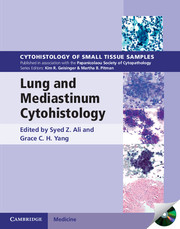Book contents
- Frontmatter
- Contents
- Contributors
- 1 Introduction to lung cytopathology and small tissue biopsy
- 2 Normal anatomy, histology, and cytology
- 3 Infectious diseases
- 4 Other non-neoplastic lesions
- 5 Benign lung tumors and tumor-like lesions
- 6 Squamous, large cell, and sarcomatoid carcinomas
- 7 Adenocarcinoma
- 8 Neuroendocrine neoplasms
- 9 Uncommon primary neoplasms
- 10 Metastatic and secondary neoplasms
- 11 Anterior mediastinum
- 12 Middle and posterior mediastinum
- 13 Role of ancillary studies
- Index
- References
13 - Role of ancillary studies
Published online by Cambridge University Press: 05 January 2013
- Frontmatter
- Contents
- Contributors
- 1 Introduction to lung cytopathology and small tissue biopsy
- 2 Normal anatomy, histology, and cytology
- 3 Infectious diseases
- 4 Other non-neoplastic lesions
- 5 Benign lung tumors and tumor-like lesions
- 6 Squamous, large cell, and sarcomatoid carcinomas
- 7 Adenocarcinoma
- 8 Neuroendocrine neoplasms
- 9 Uncommon primary neoplasms
- 10 Metastatic and secondary neoplasms
- 11 Anterior mediastinum
- 12 Middle and posterior mediastinum
- 13 Role of ancillary studies
- Index
- References
Summary
Ancillary studies can play a valuable role in establishing a morphologic diagnosis of both neoplastic and non-neoplastic conditions of the lung and mediastinum. Ancillary techniques include immunocytochemistry, flow cytometry, and molecular pathology techniques. Currently, the most significant in terms of clinical utility and widespread applicability is the role of immunocytochemical stains. Flow cytometry is invaluable in the diagnosis and classification of hematopoietic neoplasms. Molecular techniques are being used with increasing frequency, particularly fluorescence in situ hybridization (FISH) although, at the present time, there are only a limited number of clinical applications. In addition, few hospital laboratories are currently capable of performing these technically demanding techniques, especially when applied to cytology specimens.
Fine needle aspiration and exfoliative cytopathology of the lung are widely used, minimally invasive procedures for the evaluation of lung lesions. The spectrum of neoplastic and non-neoplastic lung lesions is wide and the characteristic morphology of each of these is well described in previous chapters. Tumors of the lung include a diverse group of epithelial and non-epithelial neoplasms. Within epithelial neoplasms, the utility of immunocytochemical stains is in the diagnosis of primary and metastatic carcinomas with a very limited role in benign epithelial tumors. Mesenchymal tumors in the lung are somewhat less common and there are only a few entities wherein immunocytochemical stains are valuable. In malignant melanoma, in addition to the well-established markers S-100 protein and HMB45, there are more recent antibodies that may aid the diagnosis of metastatic melanoma. When evaluating carcinomas of the lung, the majority of these tumors can be readily diagnosed and classified on morphology alone. However, there is a broad spectrum of morphology within each of these tumors with often overlapping cytologic features. Additionally, a variety of metastatic carcinomas can mimic primary lung tumors. Immunocytochemistry can be extremely valuable in the following scenarios:
Confirming the diagnosis of a primary carcinoma of lung
Classifying primary tumor of lung into a specific subtype
Identifying metastatic cancers to the lung and confirming the anatomic site of the primary tumor
Identifying mesenchymal, hematopoietic, and other miscellaneous tumors of the lung
Identification of prognostic and predictive markers for potential therapeutic intervention
The majority of this chapter will be devoted to the use of immunocytochemistry to supplement morphologic diagnosis. We will use the term “immunocytochemistry” here for cytology specimens and not immunohistochemistry, which is generally reserved for discussions pertaining to tissue sections.
- Type
- Chapter
- Information
- Lung and Mediastinum Cytohistology , pp. 258 - 278Publisher: Cambridge University PressPrint publication year: 2000

